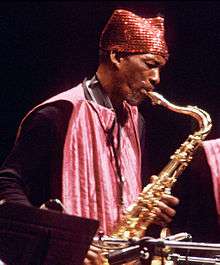John Gilmore (musician)
John Gilmore (September 28, 1931 – August 20, 1995) was an American jazz saxophonist known for his tenure with the avant-garde keyboardist/bandleader Sun Ra from the 1950s to the 1990s.[1]
John Gilmore | |
|---|---|
 | |
| Background information | |
| Birth name | John Gilmore |
| Born | September 28, 1931 Summit, Mississippi, U.S. |
| Died | August 20, 1995 (aged 63) Philadelphia, Pennsylvania, U.S. |
| Genres | Avant-garde jazz, Bebop, Free jazz, Post-bop |
| Occupation(s) | Musician, composer |
| Instruments | Tenor saxophone, drum set, bass clarinet |
| Years active | 1952–1995 |
| Associated acts | Sun Ra, Clifford Jordan, Horace Silver, Freddie Hubbard, Dizzy Reece, Art Blakey, Elmo Hope, Andrew Hill |
Biography
Gilmore was raised in Chicago and played clarinet from the age of 14.[2] He took up the tenor saxophone while serving in the United States Air Force from 1948 to 1952, then pursued a musical career, playing briefly with pianist Earl Hines before encountering Sun Ra in 1953.
For the next four decades, Gilmore recorded and performed almost exclusively with Sun Ra. This was puzzling to some, who noted Gilmore's talent, and thought he could be a major star like John Coltrane or Sonny Rollins. Despite being five years older than Gilmore, Coltrane was impressed with his playing, and took informal lessons from Gilmore in the late 1950s. Coltrane's epochal, proto–free jazz "Chasin' the Trane" was inspired partly by Gilmore's sound. The Penguin Guide to Jazz suggests Gilmore remained an influence in Coltrane's later period, particularly on Sunship.[3]
In 1957, he co-led with Clifford Jordan a Blue Note session which resulted in the album Blowing in from Chicago. The rhythm section featured Horace Silver, Curly Russell, and Art Blakey. In the mid-1960s, Gilmore toured with the Jazz Messengers and he participated in recording sessions with Paul Bley, Andrew Hill (Andrew!!! and Compulsion), Pete La Roca (Turkish Women at the Bath), McCoy Tyner (Today and Tomorrow) and a handful of others. In 1970, he co-led a recording with Jamaican trumpeter Dizzy Reece. His main focus throughout, however, remained with the Sun Ra Arkestra.
Gilmore's devotion to Sun Ra was due, in part, to the latter's use of harmony, which Gilmore considered both unique and a logical extension of bebop. Gilmore had stated that Sun Ra was "more stretched out than Monk"[4] and that "I'm not gonna run across anybody who's moving as fast as Sun Ra ... So I just stay where I am."[5]
Gilmore occasionally doubled on drums and also played bass clarinet until Sun Ra hired Robert Cummings as a specialist on the latter instrument in the mid-1950s. However, tenor sax was his main instrument and Gilmore himself made a huge contribution to Sun Ra's recordings and was the Arkestra's leading sideman, being given solos on almost every track on which he appeared. In the Rough Guide to Jazz, Brian Priestley says:
Gilmore is known for two rather different styles of tenor playing. On performances of a straight ahead post-bop character (which include many of those with Sun Ra), he runs the changes with a fluency and tone halfway between Johnny Griffin and Wardell Gray, and with a rhythmic and motivic approach which he claims influenced Coltrane. On more abstract material, he is capable of long passages based exclusively on high-register squeals. Especially when heard live, Gilmore was one of the few musicians who carried sufficient conviction to encompass both approaches.
After Sun Ra died in 1993, Gilmore led Ra's Arkestra for a few years before his own death from emphysema.[6] Marshall Allen then took over leading the Arkestra.
Discography
As co-leader
- Blowing in from Chicago (Blue Note, 1957) co-leader with Cliff Jordan,
As sideman
For albums with Sun Ra see the Sun Ra discography
With Paul Bley
- Turning Point (Improvising Artists, 1975 rec. 1964)
With Freddie Hubbard
- The Artistry of Freddie Hubbard (Impulse!, 1962)
With McCoy Tyner
- Today and Tomorrow (Impulse!, 1963)
With Elmo Hope
With Andrew Hill
- Andrew!!! (Blue Note, 1964)
- Compulsion! (Blue Note, 1966)
With Art Blakey
- 'S Make It (Limelight, 1965)
With Pete La Roca
- Turkish Women at the Bath (Douglas, 1967) also released as Bliss!
With Phil Upchurch
- Feeling Blue (Milestone, 1967)
With Dizzy Reece
- From In to Out (Futura, 1970)
References
- John Gilmore: Self-Effacing Disciple of Sun Ra, The Scotsman, 1995 – accessed April 29, 2013
- Lock, Graham (1994). Chasing the Vibration. Devon: Stride Publications. pp. 156–163. ISBN 1-873012-81-0.
- Cook, Richard; Morton, Bryan (2002). The Penguin Guide to Jazz (6th ed.). London: Penguin. p. 320.
- Campbell, Robert L. "FROM SONNY BLOUNT TO SUN RA: The Birmingham and Chicago Years". Retrieved June 23, 2007.
- Corbett, John. "John Gilmore". Retrieved June 23, 2007.
- Pareles, J. John Gilmore, 63, Saxophonist In the Avant-Garde of Jazz, New York Times, August 22, 1995